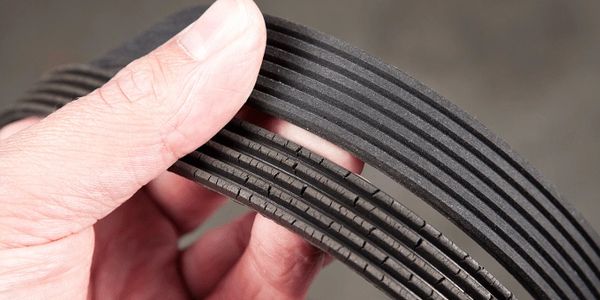October 25th is the NEXT Service Smart Saturday!
Belts & Hoses
Belts

Your car's accessory drive belt works in a hostile environment. It powers the alternator, AC compressor, water pump, and other accessories that make your vehicle ride safe and comfortable all the while enduring blistering summer heat, freezing winter chill, and assault by stones, dirt, oil, and moisture.
This perpetual punishment places a great deal of stress on the car belt(s), which will eventually wear out.
Hoses

Hoses are vital components to a vehicle. They act as the veins of the car and virtually every system of your vehicle is equipped with them. The maintenance on some of these hoses is imperative to avoid complete system failure. The most prone to failure as vehicle age would be the upper and lower radiator hoses.
Worn hoses typically show signs of cracking, bugling or crunching when squeezed.
Car Belts
Additional Information
The belt's job is to transfer power to all accessories. By wedging the belt ribs into the pulley, creating friction. The tension needed to create the wedging force is provided by the tensioner.
Belt material changed from Neoprene to EPDM in the late 1990's which changed the belt inspection process from looking for cracks to checking rib wear. EPDM belts wear out gradually, much like a tire, and typically don't show the gradual, physical signs of wear (cracking, chunking, pilling, etc.) that Neoprene belts did.
Function: Transfers power from one component to another. For example the serpentine belt transfers power from the crankshaft to the alternator.
Signs of Wear: Cracking, splitting and/or squealing belt, dimming headlights while driving, loss of battery charge.
The distinct wear patterns can help discover the underlying reasons for the failure of your belt - often the tensioner or pulley - and prevent reoccurrence of the problem. Examples of belt wear patterns include; rib cracking, fluid contamination, uneven rib wear, misalignment, gavel/sand penetration, rib separation, and rib chuck-out.
Belt Accessory Parts
Belt tension is the key to proper functioning of the accessory belt drive system. Worn belt tensioners loses damping ability creating excess play. Common failures linked to tensioners include belt slipping, misalignment, failure of the tension damper, insufficient belt-pulley contact and the obvious weak tensioner.
Today's modern vehicles require the belt tensioners to be replaced at the same time as the belts, and for the technician to physically inspect all additional relevant pulleys of the system while the belt is off.
Learn More
Drive belts should be inspected every 60,000 miles and replaced every 90,000 miles according to Gates Corp. (a major and well respected original equipment belt manufacturer) or 7 years.
Car Hoses
Additional Information
Many different vehicle systems rely on hoses to transport the necessary oil and fluids to different mechanical components. You have brake hoses, power steering hoses (which are under extreme pressures), coolant hoses (dealing with high heat), as well as air conditioning lines/hoses and evaporative emission hoses (helping us minimize our vehicle's emissions footprint and when damaged can cause the illumination of the check engine light).
Function: The hoses route coolant throughout the engine while the hose clamps secure the hoses in place.
Signs of Wear: Indications of hose leaking, cracking, splitting, hardening, brittleness or lack of heat in vehicle cabin.
Many respected hose manufactures recommend to replace them every 10 years or 100,000 miles (when properly maintaining your cooling system) and to begin checking them each time you come into an auto repair shop with frequency after five years or 50,000 miles.

You can see the build up forming inside the hoses. This hose was also stiff to the touch.
Belt Video 1
General explanation of belt, belt pulley, belt tensioner, and possible failures.
Belt Video 2
Official video from Gates An Original Equipment Manufacturer that goes more in depth about the belt systems.
Cooling System Hoses
Replacing car radiator hoses has been recommended as a maintenance item since the 1980s. It's often forgotten and extremely important especially if your vehicle has more than 100,000 miles.
Professional Auto Care has been offering auto repair and maintenance services since 1983 in the Southwest Houston neighborhoods. We offer belts and hoses advice and replacement by certified professionals. We are located just outside Sugar Land and Missouri City. Feel free to call to speak to a certified professional if you have questions about your belts and hoses maintenance intervals.
Copyright © 2025 Professional Auto Care - All Rights Reserved.
Privacy Policy is available on the Contact Us Page.
Disclosure: PAC is a participant in the Amazon Services LLC Associates Program, an affiliate advertising program designed to provide a means for sites to earn advertising fees by advertising and linking to Amazon.com.
Hello there!
On our website, you can make reservations (ie. for state inspections, maintenance), find pricing, and learn more about us.
We do NOT provide estimate requests or quotes over the phone.
Next Service Smart Saturday = November 22nd.
We will be CLOSED week of Thanksgiving.